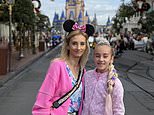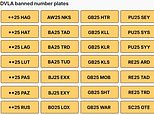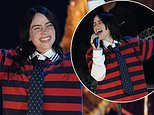NASA just released the James Webb Space Telescope's most adorable photo yet.
The American space agency shared an image of what looks like a penguin and an egg located roughly 326 million light-years away from Earth.
But the telescope actually captured two galaxies, known as ARP 142, joined by a blue haze that's made up of stars and gas.
Their interaction began between 25 and 75 million years ago, when the penguin (originally called NGC 2936) and the egg (NGC 2937) first passed by each other.

Webb is considered the most powerful telescope ever launched into space. It specializes in capturing infrared light, which is why it was able to photograph these two galaxies in stunning detail.
'In just two years, Webb has transformed our view of the universe, enabling the kind of world-class science that drove NASA to make this mission a reality,' Mark Clampin, director of the Astrophysics Division at NASA Headquarters, said in a press release.
On Friday, which marked two years since NASA unveiled Webb's first space images, the space agency released a new near- and mid-infrared image of the two interacting galaxies.
Webb observes infrared light using a combination of two instruments, the Near-Infrared Camera (NIRCam) and the Mid-Infrared Instrument (MIRI).
NIRCam detects light from the earliest stars and galaxies in the formation process, the population of stars in nearby galaxies, and young stars in the Milky Way and Kuiper Belt objects.
Webb’s MIRI features both a camera and a spectrograph, which separates incoming light by its frequency and records the resulting spectrum.
MIRI also has sensitive detectors that lets it see redshifted light of distant galaxies, newly forming stars, and faintly visible comets as well as objects in the Kuiper Belt.

This allows scientists to see cosmic objects that aren't visible to the human eye, and it's led to some groundbreaking discoveries.
In the two years since its launch, Webb has imaged the oldest known galaxies in the universe, previously invisible stages of star formation, and more.
This new image is yet another example of Webb's infrared-detecting power.
Before the galaxies mingled, the penguin was shaped like your average spiral galaxy rich in gas and dust.
But the gravitational pull of the egg warped its shape.
Now, it's center gleams like an eye, and its galactic arms have formed the image of a beak, head, backbone, and tail.
The interaction between these two galaxies has pulled on the penguin's inner regions of thin gas an dust, causing them to condense and form new stars.
That can be observed in the 'fish' the penguin is holding in its beak, and in the 'feathers' of its tail, according to NASA.
Meanwhile, the shape of the egg has remained largely unchanged.

That's partly because it's an elliptical galaxy, which means that it's filled with aging stars and contains less gas and dust to be pulled on by exterior gravitational forces. If both were spiral galaxies, this unique picture wouldn't have taken shape.
In the top right corner of Webb's snapshot is another galaxy photobombing the image.
This galaxy, called PGC 1237172, is about 100 million light-years closer to Earth.
Webb observed it from the side, which is why it appears edge-on.
And its filled with young stars, which are sparkling bright blue in the image.
In the background, Webb's photo is teeming with even more distant galaxies. This goes to show just how sensitive and high-resolution Webb's infrared instruments are, according to NASA.
Even though the penguin and the egg are locked in a cosmic dance, they're still about 100,000 light-years away from each other - but that's actually quite close on cosmological scales.
Eventually, they will merge into a single galaxy, but that won't happen for hundreds of millions of years.
In the meantime, Webb will continue exploring and documenting the farthest reaches of the universe.












